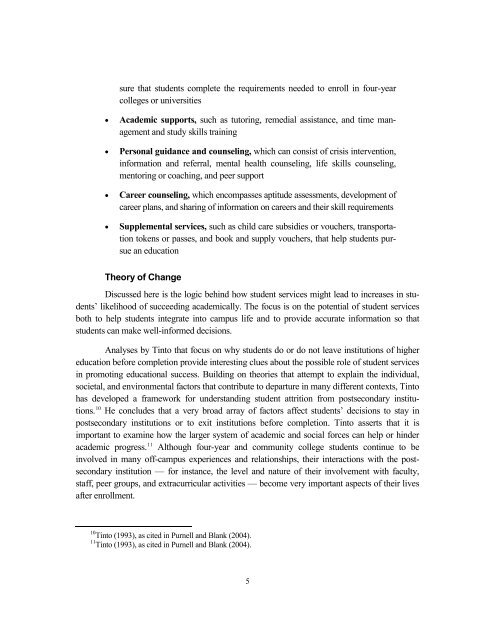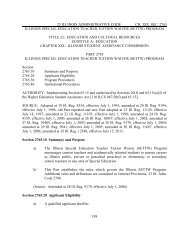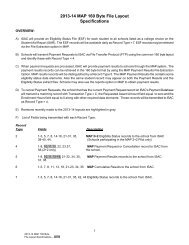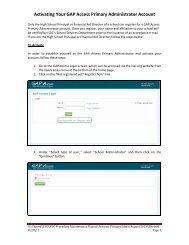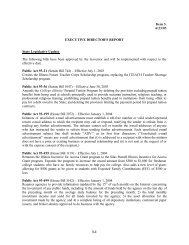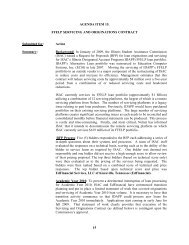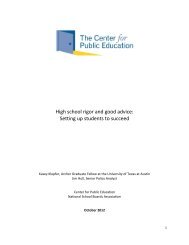Doors services or to a control group that received only the college’s standard services. Bothgroups were tracked over time to determine which group attained better outcomes (such ascredits earned and retention). Random assignment ensures that the motivation levels andpersonal characteristics of students in the program group and control group were similar at thebeginning of the study; 8 hence, any subsequent substantial differences in outcomes can beattributed with a high level of confidence to differences in the way students were treated afterthey were randomly assigned. Using statistical techniques, studies that do not utilize a randomassignment research design are still capable of accounting for observable differences (in suchvariables as gender, race, and income) between the program group and a comparison group.However, one major advantage of the random assignment design is that, since program andcontrol group members are assigned at random, the two groups will, on average, be equivalenton both observed characteristics and unobserved characteristics (such as motivation and ability).For this reason, the experimental design is ideal for attempting to make causal inferences abouta program’s effectiveness.This report focuses on one of the Opening Doors programs designed to increase students’chances of achieving academic success: enhanced student services and a modest stipend.The following sections provide some background on student services in the community collegesetting; a detailed description of the Opening Doors program implemented at Lorain CountyCommunity College and Owens Community College appears in Chapter 3.Background on Student Services at Community CollegesComponents of Student ServicesTo begin, it is important to consider what is meant by student services. Definitions canvary, but the following catalog of their elements — developed as part of an earlier MDRCpublication on student services 9 — offers one useful, relatively comprehensive description ofwhat student services encompass:• Academic guidance and counseling, including orientation, information onnavigating the college, reading and math assessments, educational planningand advising that helps students select courses to meet major requirementsthat fit their career goals, monitoring students’ progress to ensure that theyreach educational benchmarks in a timely way, early registration, forums orpresentations on topics to help students persist, and transfer counseling to en-8 The program group and control group should be similar in terms of averages, as well as other distributionalcharacteristics.9 Purnell and Blank (2004).4
sure that students complete the requirements needed to enroll in four-yearcolleges or universities• Academic supports, such as tutoring, remedial assistance, and time managementand study skills training• Personal guidance and counseling, which can consist of crisis intervention,information and referral, mental health counseling, life skills counseling,mentoring or coaching, and peer support• Career counseling, which encompasses aptitude assessments, development ofcareer plans, and sharing of information on careers and their skill requirements• Supplemental services, such as child care subsidies or vouchers, transportationtokens or passes, and book and supply vouchers, that help students pursuean educationTheory of ChangeDiscussed here is the logic behind how student services might lead to increases in students’likelihood of succeeding academically. The focus is on the potential of student servicesboth to help students integrate into campus life and to provide accurate information so thatstudents can make well-informed decisions.Analyses by Tinto that focus on why students do or do not leave institutions of highereducation before completion provide interesting clues about the possible role of student servicesin promoting educational success. Building on theories that attempt to explain the individual,societal, and environmental factors that contribute to departure in many different contexts, Tintohas developed a framework for understanding student attrition from postsecondary institutions.10 He concludes that a very broad array of factors affect students’ decisions to stay inpostsecondary institutions or to exit institutions before completion. Tinto asserts that it isimportant to examine how the larger system of academic and social forces can help or hinderacademic progress. 11 Although four-year and community college students continue to beinvolved in many off-campus experiences and relationships, their interactions with the postsecondaryinstitution — for instance, the level and nature of their involvement with faculty,staff, peer groups, and extracurricular activities — become very important aspects of their livesafter enrollment.10 Tinto (1993), as cited in Purnell and Blank (2004).11 Tinto (1993), as cited in Purnell and Blank (2004).5
- Page 1: OPENING DOORSMORE GUIDANCE,BETTER R
- Page 4 and 5: Funders of the Opening Doors Projec
- Page 7 and 8: ContentsOverviewList of Tables, Fig
- Page 9 and 10: List of Tables, Figures, and BoxesT
- Page 11: PrefaceIf approved by Congress, the
- Page 14 and 15: guidance on the study. Thomas Brock
- Page 16 and 17: • The Ohio colleges successfully
- Page 18 and 19: Program group members were assigned
- Page 20 and 21: • For the most part, the program
- Page 22 and 23: offered, but might also provide stu
- Page 25 and 26: Chapter 1IntroductionOver the last
- Page 27: The Opening Doors DemonstrationTabl
- Page 31 and 32: While the mechanism through which s
- Page 33 and 34: imately 1,700 to 1 in 2001. 22 Exac
- Page 35: of literature exist on career couns
- Page 38 and 39: The CollegeLorain County Community
- Page 40 and 41: • Were beginning freshmen or cont
- Page 42 and 43: The Opening Doors DemonstrationTabl
- Page 44 and 45: Table 2.1 (continued)SOURCE: MDRC c
- Page 46 and 47: Lorain and Owens Financial Aid Data
- Page 49 and 50: Chapter 3The Implementation of the
- Page 51 and 52: Toward the end of each student’s
- Page 53 and 54: meet with their counselor a minimum
- Page 55: The Opening Doors DemonstrationTabl
- Page 59 and 60: Appendix Table C.2 shows informatio
- Page 61: Opening Doors counselors, and progr
- Page 64 and 65: Program Control Difference Standard
- Page 67 and 68: Chapter 4The Effects of Enhanced St
- Page 69 and 70: Program SemestersTable 4.1 (page 47
- Page 71 and 72: Program Control Difference Standard
- Page 73 and 74: Program Control Difference Standard
- Page 75 and 76: The Opening Doors DemonstrationTabl
- Page 77 and 78: Transcript Outcomes by GenderAssess
- Page 79 and 80:
Program Control Difference Standard
- Page 81 and 82:
Program Control Difference Standard
- Page 83 and 84:
correspond with the program’s imp
- Page 85 and 86:
Chapter 5Summary and ConclusionsLor
- Page 87 and 88:
The Opening Doors DemonstrationFigu
- Page 89 and 90:
An alternative interpretation of th
- Page 91:
Appendix ASupplementary Baseline In
- Page 94 and 95:
Full Program ControlCharacteristic
- Page 96 and 97:
Appendix Table A.1 (continued)Full
- Page 98 and 99:
Full Program ControlCharacteristic
- Page 100 and 101:
Appendix Table A.2 (continued)Full
- Page 102 and 103:
Appendix Table A.3 (continued)Full
- Page 105:
Appendix BSurvey Response Analysis
- Page 108 and 109:
Background Characteristics of Surve
- Page 110 and 111:
Table B.1 (continued)Characteristic
- Page 112 and 113:
The Opening Doors DemonstrationAppe
- Page 114 and 115:
Table B.2 (continued)SOURCE: MDRC c
- Page 116 and 117:
Table B.3 (continued)Characteristic
- Page 118 and 119:
The Opening Doors DemonstrationAppe
- Page 120 and 121:
Table B.4 (continued)SOURCE: MDRC c
- Page 122 and 123:
Table B.5 (continued)Characteristic
- Page 124 and 125:
The Opening Doors DemonstrationAppe
- Page 126 and 127:
Table B.6 (continued)SOURCE: MDRC c
- Page 129 and 130:
Lorain OwensProgram ProgramOutcome
- Page 131 and 132:
Lorain County Community CollegeOwen
- Page 133:
Appendix DDescription of Scales Pre
- Page 136 and 137:
4. I hardly ever expect things to g
- Page 138 and 139:
Social Support and Civic Engagement
- Page 140 and 141:
Psychological Distress (6-item summ
- Page 143 and 144:
Lorain County Community CollegeOwen
- Page 145 and 146:
Lorain County Community CollegeOwen
- Page 147 and 148:
Lorain County Community CollegeOwen
- Page 149 and 150:
Male SubgroupFemale SubgroupDiffere
- Page 151 and 152:
Male SubgroupFemale SubgroupDiffere
- Page 153 and 154:
Male SubgroupFemale SubgroupDiffere
- Page 155 and 156:
Lorain County Community CollegeOwen
- Page 157 and 158:
Appendix Table E.7 (continued)SOURC
- Page 159 and 160:
Lorain County Community CollegeOwen
- Page 161 and 162:
The Opening Doors DemonstrationAppe
- Page 163 and 164:
Appendix Table E.10 (continued)SOUR
- Page 165 and 166:
ReferencesAdelman, Clifford. 2004.
- Page 167 and 168:
EARLIER MDRC PUBLICATIONS ON OPENIN
- Page 169:
About MDRCMDRC is a nonprofit, nonp


